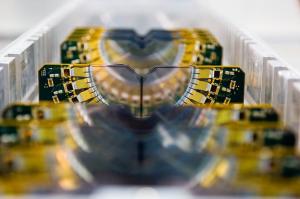LHCb observes two new baryon particles
The collaboration for the LHCb experiment at CERN's Large Hadron Collider announced the discovery of two new particles in the baryon family. The particles, known as the Xi_b'- and Xi_b*-, were predicted to exist by the quark model but had never been seen before. High precision studies such as this are very important as it will help us to differentiate between Standard Model effects and anything new or unexpected in the future.

A total of 42 VELO modules are used in the subdetector for LHCb, built by the Universities of Glasgow and Liverpool
This research finding had substantial UK involvement and is yet another demonstration of the important contribution made by the UK particle physics community to the success of the projects being undertaken on the Large Hadron Collider at CERN.
Speaking of this latest finding Tara Shears, Professor of experimental particle physics and University of Liverpool LHCb group lead said "These results underline what a wonderfully precise instrument the LHCb detector is. LHCb physicists have exploited this precision to confirm more of the Standard Model's predictions, and shown how remarkably well the theory describes our data."
The results match up with predictions based on the theory of Quantum Chromodynamics (QCD). QCD is part of the Standard Model of particle physics, the theory that describes the fundamental particles of matter, how they interact and the forces between them. Testing QCD at high precision is a key to refine our understanding of quark dynamics, models of which are tremendously difficult to calculate.
Doctor Sneha Malde, Postdoctoral Researcher in Physics at the University of Oxford said “This result is a wonderful outcome from the current round of work undertaken at the LHCb experiment. These results demonstrate yet again how successful the LHCb collaboration are in confirming the existence of particles predicted in the Standard Model.
The analysis requires significant use of the VELO and RICH sub-detectors for observing the decay and identifying the type of particles into which it decays. These sub-detectors have significant input from the UK in their design, construction, and operation."
Chris Parkes, Professor of experimental particle physics at the University of Manchester added “Not only are we seeing experimental results never before recorded but we are also confirming the existence of particles previously only predicted in the Standard Model. Showing just how important the precision of the LHCb detector is to this research.”
Source: Science and Technology Facilities Council
- 307 reads
Human Rights
Fostering a More Humane World: The 28th Eurasian Economic Summi

Conscience, Hope, and Action: Keys to Global Peace and Sustainability

Ringing FOWPAL’s Peace Bell for the World:Nobel Peace Prize Laureates’ Visions and Actions

Protecting the World’s Cultural Diversity for a Sustainable Future

Puppet Show I International Friendship Day 2020

